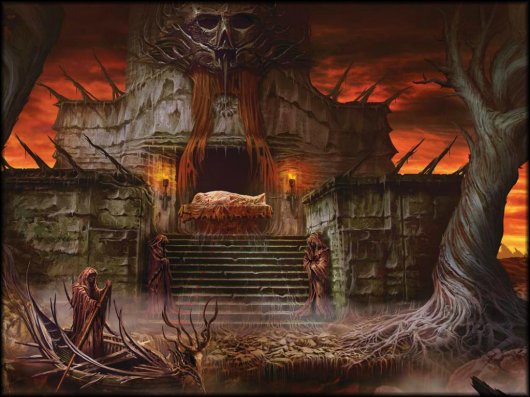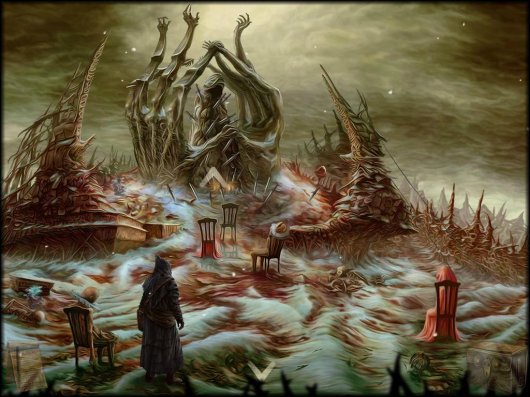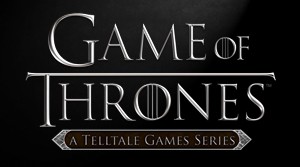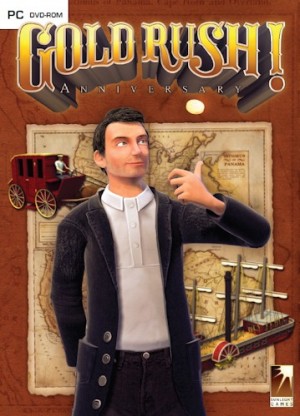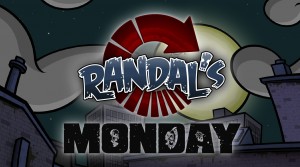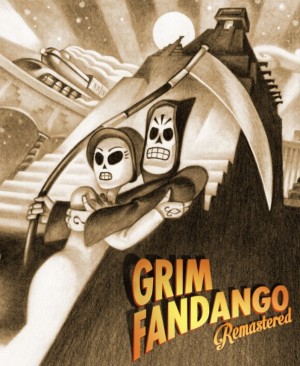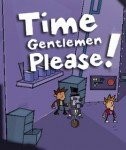Review for Tormentum: Dark Sorrow

Although most often associated with the movie Alien for his design work on the Necromorph monster, in the early 1990s Swiss surreal artist H. R. Giger made his debut in the video game world with the Dark Seed series, which featured his signature dark, morbid artwork and a terrifying story. Twenty years later, though the artist himself passed away in 2014, Giger’s legacy in the genre lives on. After a successful crowdfunding campaign, Polish indie OhNoo! Studio's horror-themed adventure Tormentum: Dark Sorrow presents a game inspired by Giger and Poland's own surrealist painter Zdzislaw Beksinski. Though easy puzzles, a lack of adequate characterization, and an absence of scares may drive some players away, those who simply want to gorge themselves on beautifully dark scenery will want to stick around for the few hours it takes to breeze through what the game has to offer.
Graphically, Tormentum's influences are worn proudly on its blood-soaked sleeves. Both Giger and Beksinski are known for their unique macabre styles: Giger for bold and disturbing "biomechanical" art, featuring nightmarish integration of humanoid and animal forms with machines, and Beksinski for dreamlike works in which creatures and architecture seem to emerge from intricate, flowing structures that resemble bent twigs or bone. Beksinski's influence is actually the more obvious inspiration throughout Tormentum, such as when a face or nude female figure appears in the twisting forms of a wall or a massive cathedral whose ribbed, organic facade seems to grow out of the very ground beneath it. Giger's influence is less obvious at first glance, though certainly evident in several monsters – one of which is clearly an homage to the Necromorph – and a few room designs, though even the most Gigeresque works in the game are tinged with Beksinski's flowing, organic style.
This is certainly not another Dark Seed, even with Giger's influence, but that's not a bad thing by any means. Egyptian themes and even the slightest hint of Art Nouveau make brief appearances at certain points along the way. When combined with Beksinski's signature influences, such flourishes make for a daring combination of styles that surprised me greatly because it works so well. If the goal was to create a macabre yet visually sumptuous game, the developers have succeeded wildly here.
Locations are varied as well, and fit in with the hellish, decrepit environment. Players begin their journey in a castle full of passages and rooms, but eventually the game moves outdoors, where occasional bouts of fire and brimstone rain down on a desolate, inhospitable landscape. Areas such as an old mine, an ancient tomb, and even a farm with a living, ghastly scarecrow that's lost its ability to frighten birds provide some variety to the creepy settings. As outlandish as some of these elements are, they feel completely believable in the context of the surreal world in which they're placed.
Animation is limited for the most part to what's necessary or functional, such as a large machine vibrating to life or a monster rearing its head when provoked. Other minor movements include things like rats scurrying along the floor and the repetitive slicing of a sword through an unfortunate victim of torture. They’re a nice touch, but seeing these animations in action reveals their repetitive nature, most taking no more than a second or two to complete before looping back to start again. It gave me the sensation of viewing an interconnected series of paintings, and indeed, that's essentially what you get in Tormentum, creating a bit of emotional distance from what's happening onscreen.
That sense of sterility extends to the general tone of the game. The menacing atmosphere maintains a sense that evil is always present, but it only ever lurks at the edge of detection. The few torture scenes are disturbing but not really scary, the atmosphere impressively macabre but unlikely to inspire nerve-wracking tension, and the few truly startling moments in the game are worthy of a mild twitch but nothing more. The game does a good job of retaining an element of creepiness throughout, but I was hard-pressed to find anything genuinely scary to get my blood really pumping. There were plenty of moments where the developers could have dialed up the fright, but even when it seemed I might come face to face with a giant man-eating spider, the moment of terror never truly came to pass. Instead, the game simply shows the spider's legs which, while ominous, simply didn't frighten me. I hate spiders, and the most consistent way to freak me out in a game is to have a giant spider make an appearance, but Tormentum largely wasted the opportunity.
Music is surprisingly varied, ranging from chanting vocal tracks, eerie strains of organ-like synthesizers, and even a country-themed guitar piece, to name just a few. In general the score enhances the atmosphere of each location, heightening the tension at appropriate moments without ever becoming annoying or over-the-top. The sonic elements aren't as stunning as Tormentum's visuals, but the sound effects are sufficiently immersive. Footsteps pound when using a flight of stairs, and things like the rush of a blazing furnace are convincing. More fantastical sounds like a monster's roar and audio feedback from a puzzle also do their part to enhance the experience.
Scattered throughout this gorgeously disturbed world are a wide variety of puzzles, from connecting one side of a circuit to the other by rotating colored traces into the correct pattern, to placing gears on the correct pegs to open a door, to brewing up a poisonous concoction to clear a hideous monster from your path. There's no shortage of activities for you to engage in, and most of them are well-designed, just fairly basic in their implementation. Some were new to me, such as a clock-styled combination lock that requires a precise sequence of presses in order to unlock, but more often than not the puzzles are not unique to Tormentum, many having been used numerous times over the years.
Veteran adventurers are likely to be disappointed in the almost non-existent challenge the puzzles present, though players looking for a more laid-back set of brainteasers, or those new to the genre, will likely be satisfied with what they find here. Even the dreaded slider puzzle, which normally sends chills down my spine, crumpled like a paper demon in just a couple of minutes. The greatest challenge came from a tangram-like puzzle where you must fit a set of geometric shapes into a square board correctly – in this case so that you can retrieve a key – but this puzzle, too, requires more patience than brainpower, solvable in just a few minutes. Inventory obstacles are likewise simple, such as bringing characters one or more desired objects, using a key to unlock a door, or finding the parts to repair broken machinery. There are no combinations required, and it's always obvious from simple deduction (or clues left for the player) what items go where.
Other tasks you encounter generally fit the nightmarish atmosphere, such as repairing a machine that conjures up a spirit who can help you and gaining access to an old mine inhabited by a monster. There are also some other pleasantly surprising tasks, such as figuring out how to get a creepy old locomotive working again or sprucing up (or destroying) an old painter's works of art. I would have preferred a greater challenge overall, but the lighter difficulty just meant easier access from one deliciously morbid scene to another.
Tormentum's puzzle issues could have been overshadowed by a really juicy narrative, but the story has issues, too. The basic premise is intriguing enough and the writing is crisp and enjoyable, but with only 3-5 hours of gameplay, the story ultimately feels like a compressed version of a longer tale, with barely any time at all to get going before the game is over. Given more time, maybe the story could have reached the philosophical and narrative heights to which it aspired, but as it is it feels rushed and perfunctory.
The game begins with the unnamed protagonist locked in a cage on the underside of a flying zeppelin. Beside you in a cage of his own is a strange rat-like creature who informs you that you are being taken to a castle where the rulers of this land imprison those marked by evil. You come to find out from the guard who locks you in your castle cell that you will be tortured for your sins, in order to cleanse your soul. You have no idea what you have done to deserve this fate, and decide that escape is your best hope of survival. Spurring you on is an image of a statue that you see in your dreams, and your ultimate quest is to find that statue in the hope that your memories will return.
As shown in a quote at the very start of the adventure, underlying the story is 18th century philosopher Immanuel Kant's "categorical imperative," a version of the Golden Rule: Treat other people not only as a means to an end, but as an end in themselves (in other words, with dignity). Given this high-minded inspiration, there was a lot of potential to craft an insightful look at human nature when trapped in a figurative hell. To this end, the game features a morality system, where you are given a choice to perform certain actions or aid various characters. In one example you must retrieve a key from a guard by sabotaging a torture machine, currently being used by the guard on an unfortunate prisoner. You can choose either a peaceful solution or a violent one to achieve the same goal.
Player choice is certainly welcome, but it is usually blatantly obvious which option is the moral one and which is immoral, and whatever decision you make is of little consequence, anyway. Giving an item of power to an evil character doesn't really change the course of the game any more than giving it to the morally upstanding one does. The puzzles remain the same, and the locations you visit are unchanged aside from swapping certain characters for others. The only true change is a different ending, but even this amounts to little more than alternate dialogue and a different animation sequence.
Consequences aside, the impact of moral dilemmas relies on players making an emotional connection to the characters. If done well, it can add significant weight to your choices, even if it’s largely illusory, but in Tormentum it just feels soulless. Much of this has to do with the characters themselves. There are plenty of both corporeal and ghostly men and beasts, such as a malevolent jester, a pair of strange insectoid guards, and an anthropomorphic lizard. Visually they are interesting, of course, but they suffer from a one-dimensionality that makes it difficult to care about their fates, which undermines the ethical quandaries involving them. With a rather large cast, most of the characters have bit parts at best, and there’s almost no chance to become attached even to those making multiple appearances, whose lives are supposed to matter.
The point-and-click interface is extremely easy to come to grips with, with a single click used for everything from inventory selection to character interaction. Pulsing halos of light indicate points of interest onscreen, like letters that can be read (which either propel the story along, provide clues for a puzzle, or both) and items that can be picked up, eliminating pixel hunting issues entirely. Dialogue is text-only and displays at the bottom of the screen, the speaker indicated by an appropriate still image beside it. Players can click through the text at their own pace – a concern for those who, like myself, tend to read slowly and take notes along the way. Not that you'll actually need to take notes. On the bottom-left of the screen, opposite the inventory icon, a self-updating notation system keeps track of any clues encountered, such as drawings left by previous inhabitants, plaques containing pertinent information, and letters scattered around.
Navigation from one location to the next is also easy. Most locations are arranged in a horizontal corridor-like fashion, with arrows appearing at the sides of the screen to click on, which advances the view to the next scene with a brief fade-out transition. Doors that can be entered and stairs that can be climbed or descended have an appropriate icon denoting them, with a red "x" over those that are either locked or otherwise unavailable at the time, such as when guarded by a sentry. Each scene is slightly wider than the monitor's display, and as you move the mouse pointer across the screen to either side, the screen scrolls with it, revealing more of the current location.
The game is technically played in third-person perspective, but none of the characters, including the protagonist, actually walk anywhere onscreen. The result is a bit like navigating a series of murals in first-person, only with the main character appearing in front of each scene in an appropriate position, depending on which side of the "stage" he exited from or which door he used in the previous scene. Clicking on an item that can be picked up instantly places it in inventory, and clicking on a direction arrow immediately transitions the scene. It’s a strange effect, reminiscent of the navigation techniques used in more casual games. I suppose the trade-off is that the developers were able to create fairly large, detailed 2D environments without the perspective constraints of first-person or ambling characters obscuring the view, but it still kept me from ever feeling entirely immersed in the game.
Even with its flaws, I enjoyed my time with Tormentum: Dark Sorrow. The lack of puzzle challenge and a story that isn't given enough time or characterization to truly develop is disappointing, but ultimately the game ends up faring better than the sum of its parts would suggest. Thanks to an aesthetic that successfully melds two very different macabre art styles into a single inspired whole, the weaknesses are worth enduring just to experience the scenery and absorb the sinister atmosphere. It's impressive that the artwork manages to succeed so well, single-handedly improving an otherwise mediocre experience. This is a world you can’t help but deeply admire, even as you’re repulsed by its continually grotesque spectacles. For even passing fans of macabre surrealism that the likes of Giger and Beksinski offer, this brief and darkly beautiful homage to their body of work could be just the diversion needed to fill an idle evening or two.




